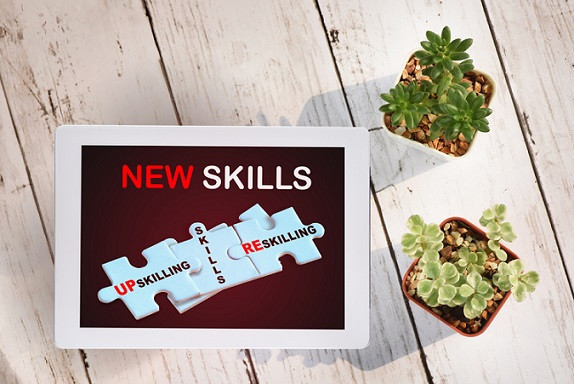[ad_1]
This article originally appeared on LinkedIn, here.
Learning and development (L&D) teams have always had two main goals:
- Equip workers with the skills they need to do the jobs they have now
- Equip workers with the skills they need to advance in their careers and serve the needs of the organization
While these are still basically true, the rapid transformation of the professional landscape means that more than ever, these are moving targets.
Today, the skills workers need to keep doing their own jobs are changing all the time, and movement within an organization can look a lot different than the traditional path.
It’s not enough for workers to learn how to do their jobs, and then learn how to do the next higher role. Today, workers need to keep learning and adapting continuously to stay effective.
This is why 59% of L&D experts worldwide say upskilling and reskilling is the #1 priority of their function. Not only because it provides employees with the versatility and growth needed to thrive in today’s environment, but also because it’s tremendously beneficial for the organization long-term.
Here are four big reasons why investing in upskilling and reskilling are essential focuses for L&D, along with a little good news about why these investments are going to keep paying dividends for years to come.
In her course on Accelerating Digital Transformation as Offices Reopen, Chief Digital Officer Laura Merling calls this era the fourth industrial revolution:
“Businesses that are not agile and those that are not operating on a modern technology platform are quickly becoming obsolete. The new business landscape requires skills in cloud computing, user experience data science, connectivity and a vast amount of other technical capabilities.”
The faster work changes, the more important building a team of lifelong learners and giving them the resources they need to learn becomes. That’s why 63% of L&D leaders agree that L&D has a permanent seat in the C-suite.
And the imperative is clear. According to Merling, “as jobs are transformed by technologies in the fourth industrial revolution, we’ll need to reskill more than one billion people by 2030.”
[Reskilling Is] One of the Best Ways To Retain Employees and Curb Employee Attrition
Back in 2018, before the pandemic arrived, 94% of employees indicated they would stay at a company longer if it invested in their career. Now think of all the changes that have occurred since then between the pandemic and the simple advancement of technology.
Research from the World Economic Forum a few years ago suggested that by 2022, 54% of employees worldwide would need significant reskilling and upskilling to continue to perform their roles competitively. Well, here we are.
Learning isn’t just about helping employees move up in their careers anymore; it’s about making their careers more durable. If you don’t provide your employees with a way to keep up with the merciless pace of professional technology, they’ll find an employer who will.
Over 40% of the global workforce considered leaving their employer in 2021, and The Great Reshuffle is far from over. Either you keep investing in retraining and upskilling your current workforce… or you’ll keep investing in hiring and onboarding.
Gen Z Wants to Learn
Gen Z is rapidly joining the workforce, and they’re bringing with them new priorities that are reshaping how employers will need to design attractive workplaces. First and foremost among these changes? Gen Z employees care about workplace learning more than any generation before them. Consider a few statistics:
- 76% of Gen Z learners believe that learning is the key to a successful career
- 69% of Gen Z learners reported that they are making more time to learn in recent years
- Gen Z learners watched 50% more hours per learner of learning content in 2020 vs. 2019
- Gen Z spends 12% more of their time on LinkedIn Learning building their hard skills when compared to the average learner.
Where is this motivation to learn coming from? Sixty-two percent of Gen Z workers believe hard skills are changing faster than ever. Fifty-nine percent don’t think their job will exist in the same form 20 years from now.
Gen Z understands technology’s continuous impact on how business is done better than anyone else — after all, they grew up with it. They know they need to keep learning to stay relevant and keep advancing. If you want to keep tomorrow’s top talent, you’ll need to show them that you know it, too.
Work Culture Benefits From Commitment to Growth and Development
The best part about embedding a culture of learning is that the investment will keep paying off in perpetuity.
Nearly two-thirds (65%) of learners agree that learning makes them more adaptable. In other words, the process of learning new skills didn’t just help employees learn those skills, it also helped them learn how to learn.
When employees experience success in professional learning on the job, it creates a flywheel effect. They begin to see the value, and they want to do it more, and others notice.
The easiest way to help employees experience learning success is by helping them get better at something they already understand and care about: in other words, by helping them upskill. This opens the door for exploring new horizons and growing capabilities via reskilling.
Final Thoughts: Learning Is Future-Proofing
Getting your workers excited to learn more is one of the single best ways you can future-proof your organization. Focusing on reskilling and upskilling is simultaneously the best way to do it and one of the best ways to solve today’s challenges.
The more your workers are prepared to learn, the more prepared they — and you — will be for the challenges and changes of tomorrow.
[ad_2]
Source link

Leave a Reply